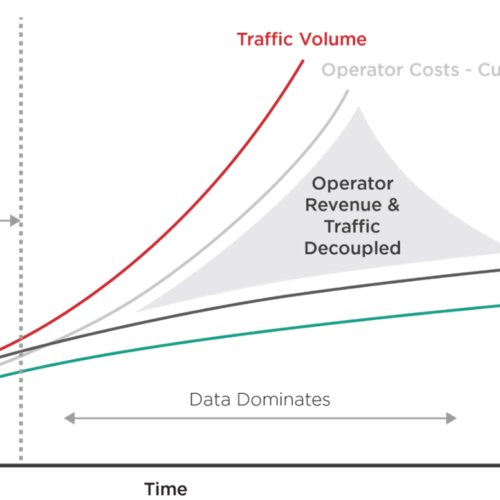Creating Scalable and Flexible Future-Proof Networks
Later today Joost Verberk, Director of Product Management will be presenting at in the Technology Showcase at the OFC Conference & Expo 2021. As he was preparing for the presentation, we sat down with him to ask him to share his thinking on the role of programmable optical system-on-chip in helping network operators create scalable and flexible networks.
In this article, Joost also looks at the challenges facing network operators today, as well as the role of open interfaces, virtualising network functions, software-defined networks and automation in realising future-proof networks.
Digital technologies have, and continue to, radically change our daily lives. Take a moment to consider all the new devices that have been introduced in just the last couple of decades – tablets, smartphones, smartwatches, and voice-assisted devices to name just a few. These devices, and the apps built for them, allow us to access information instantly, transfer money in the blink of an eye and purchase just about everything we want and need – clothes, food and much more. Technology has changed the way we entertain ourselves, consume media and socialise with each other. The advances we most relate to are those that are targeted at fun and convenience, but the technology also stretches to other areas like safety (e.g. home security) and health and well-being (portable medical devices and remote operations).
All this innovation however does come with its challenges. Challenges specifically for those that offer the infrastructure and networks that make all this possible.
As he was preparing for his Technology Showcase session for OFC 2021, we spoke to Joost Verberk to ask him to share his thinking on our digital future, the challenges facing operators, and the role that integrated photonics can play in addressing those challenges. Joost is Director of Product Management here at EFFECT Photonics and is responsible for ensuring that our products meet our customers’ expectations today and into the future.
Can you start by giving us an idea of the challenges facing the network operators today?
Although all these new devices you mention can be quite different in size and portability, there is one thing they have in common: they are all connected. In one way or another, they exchange information. That can be direct with other devices that are nearby (via Bluetooth for instance), but more often than not, they connect to cloud-based platforms through the internet. How they access the internet can vary. Some devices connect through a Wi-Fi network, and others through cable networks. It is also becoming more common for devices to connect directly to the internet through operator networks, such as 5G mobile telecom networks. In addition to how they connect, the requirements for the communication network can also be quite different depending on the application.
Can you give some examples of what you mean?
Depending on what it’s being used for, there will be different requirements in terms of bandwidth, latency, reliability, energy efficiency, the number of connected devices, costs and so on.
Nowadays it is quite common to sit across from someone on a train who is streaming the latest Netflix release on their mobile phone. This type of service requires high-res video traffic to be transferred from centralised servers to mobile devices at the edge of the network. Bandwidth here is of the utmost importance to ensure a pleasant end-user experience. No one enjoys having to wait long for a video to buffer. Other interactive applications like gaming require fast response times, also called low latency, to give a smooth and satisfying gaming experience.

Another example we have all read about is network outages on heavy traffic days like the 4th of July or the Superbowl. When larger than usual amounts of people gather in a location that is not designed to service that many people all at once, all the end-users are affected. If emergency services or critical business services also rely on those same networks, that could lead to very dangerous situations. Emergency services should always have access to the network with fast response times and guaranteed coverage. Luckily, technology allows us to do this by what we call network slicing, a technique that allocates and guarantees parts of the network for specific end-users. This vertical slicing is guaranteed from the user device (like a mobile phone) through to the core of the network.

The link with technology is fairly easy for both of these use-cases. An area that many people are maybe not so familiar with is how innovation is driving massive change in the agriculture sector. Over the past couple of decades, innovation in the use of machines has expanded the scale, speed and productivity of farming equipment, leading to more efficient cultivation of land. Technology innovations in seed, irrigation and fertilizers have also increased yield.

Now agriculture is on the brink of another revolution, driven by advances in sensing and network technology. Artificial intelligence, analytics, connected sensors and other emerging technologies could further increase yields while improving the efficient use of water and other resources. As a result, we can drive sustainability and resilience across crop cultivation and animal husbandry. These sensors, for instance, will have to be deployed in very large quantities across large areas, so they need to be small, cheap and have a very low power consumption so that they can be battery operated for years. If you extend this thinking, it means massive amounts of sporadic connections to the network, with small information exchanges where cost is a bigger driver than the need for low latency or high bandwidth.
Those are great examples and there are bound to be a lot more new use-cases that pop up as technology develops. But what are the consequences of all of this?
As the world becomes increasingly digital, network traffic is growing exponentially. We, therefore, need to create a future-proof network that is agile, scalable and flexible. But that’s not necessarily as simple as it sounds. There are two aspects to network traffic growth that cannot, or should not, follow the same exponential curve. The one is investments in infrastructure and operational costs. Operators will not be able to convince their customers that exponential price increases are acceptable. Customers are not and will not be willing to pay exponential price increases.

The other is the environmental impact of this increased network traffic growth. Quite simply put – if energy consumption grows at the same rate as bandwidth consumption, pretty soon we will need all of the world’s energy supply just to power the internet. Both financially and environmentally, this type of scaling is just not sustainable.
So what you are saying is that we need to find other ways of doing things.
We need to rethink the ways networks are deployed. Communication networks are about to go through a transformation that has already been happening in the IT industry for some time. Software-based networks play an important role in ensuring that the network infrastructure is much more flexible and better aligned, with innovation cycles that are associated with a digital world. There are a few key elements to this.
The first is creating a more “open” infrastructure – disaggregation and open interfaces open up the ecosystem in several different ways. By creating standardised interfaces, we allow the best available global services and products into the network. Moving away from proprietary hardware platforms allows the use of commercial, off-the-shelf equipment, which reduces capital expenditures by using standard high-volume servers. This reduces time to market for new solutions, avoids vendor lock-in and enables a more cost-effective roll-out of solutions.
The next piece is virtualising network functions to enable networks to be agile and capable of responding automatically to the needs of the traffic and services running on it, scaling up and down on request. Software-defined networking provides the means to dynamically control the network and the provisioning of networks as a service, which fits in well with different use-cases having different requirements from the network.
The last piece of the puzzle is automation. With the requirements on the scale and flexibility of future networks, it will no longer be practical to manage networks manually. Automated orchestration, deployment and optimisation will be non-negotiable. The ultimate goal is to create a truly self-managed, zero-touch automated network. Emerging technologies such as artificial intelligence and machine learning will make it easier for the network to become self-managed.
So creating a sustainable, future-proof data infrastructure is a necessary condition for building the next generation networks that will stand up to the ever-growing demand. How can integrated photonics play a role in making this happen?
I believe that just as electrical integration was a huge driver for the innovations of the last decades, so photonic integration will drive the innovations and the networks of the coming decades. To address the combined issues of scalability, flexibility and sustainability, employing wafer-scale technologies for optics is a crucial step forward. By integrating all the optical components needed to make an optical transceiver into a single die, we ensure that optical transceivers are cost-efficient, power-efficient and flexible. In addition, by providing open interfaces to the photonic integrated circuit (PIC), and the transceiver, we expose crucial information from the lowest level of the network up to the orchestration layers. This allows for easy (remote) monitoring of networks to enable, for example, a more optimal schedule for preventative maintenance but also the detection of cybersecurity threats.
How far off are we at the moment from making this happen?
At the moment, optical transceivers based on integrated photonics are shipping to our lead customers. Additionally, we are also conducting field trials with different operators, for instance in the Netherlands where together with VodafoneZiggo and Ericsson we are engaged in 5G network trials. Our optical System-on-Chip (SoC) technology is at the heart of our industrial temperature hardened 10Gbps tunable SFP transceiver that can be used in telecom and datacom networks. On top of that, we provide an additional management layer called NarroWave, which allows for autonomous tuning without provisioning and remote diagnostics. In the future we will be looking to increase the bandwidth our transceivers can provide by increasing the line rates, for instance to 25G, but also by moving to more advanced modulations schemes, such as QPSK for coherent transceivers. We will also be adding open interfaces to allow our customers to dynamically control the key parameters of the transceiver to optimize their networks. Our product roadmap is geared towards providing telecom and datacom operators with the means to fluently upgrade their networks to meet the capacity needs of future applications, without violating economic or sustainability limits.
